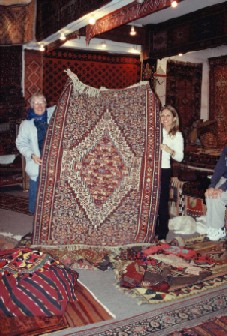|
CLIMATE
 Climate
of Turkey Climate
of Turkey
Although Turkey is situated in a
geographical location where climatic conditions are quite temperate, the
diverse nature of the landscape, and the existence in particular of the
mountains that run parallel to the coasts, result in significant differences
in climatic conditions from one region to the other. While the coastal
regions enjoy milder climates, the inland Anatolia plateau experiences hot
summers and cold winters with limited rainfall.
Because of Turkey's geographical
conditions, one can not speak about a general overall climate. In Istanbul
and around the sea of Marmara (Marmara region) the climate is
moderate (winter 4 deg.C and summer 27 deg.C); in winter the temperature can
drop below zero. In Western Anatolia (Aegean region) there is a mild
Mediterranean climate with average temperatures of 9 deg.C in winter and 29
deg.C in summer. On the southern coast of Anatolia (Mediterranean region)
the same climate can be found. The climate of the Anatolian Plateau
(Central Anatolian region) is a steppe climate (there is a great
temperature difference between day and night). Rainfall is low and there is
more snow. The average temperature is 23 deg.C in summer and -2 deg.C in
winter. The climate in the Black Sea area (Black Sea region) is wet,
warm and humid (summer 23 deg.C, winter 7 deg.C). In Eastern Anatolia
and South-Eastern Anatolia there is a long hard winter, where year
after year snow lies on the ground from November until the end of April (the
average temperature in winter is -13 deg.C and in summer 17 deg.C).Season
and Climate in Turkey Turkey is a year-round destination depending on your
itinerary. Although the tourist "high season" (with associated higher rates)
is from mid-June through mid-September, Spring and Fall are the best seasons
to travel. The sun is warm and skies are generally clear. You can expect
mild to warm temperatures and some rain during this time.
What is the
best time for traveling to Turkey ...
Below a chart of the best time to travel
is summarized based on climate(Swimming,Touring) and rates (High, Low
season).
Marmara, Aegean and
Mediterranean Coasts:
These coasts have a typical
Mediterranean climate with hot summers and mild winters. The swimming season
becomes shorter as one travels north. Because of the mountains, the east
side of the Aegean and the North side of the Mediterranean could have
regionally different climate...
|
Marmara and North Aegean : |
South Aegean
and Mediterranean: |
|
Swimming : June to
September. |
Swimming : April to
October |
|
Touring : March to
November. |
Touring : All year
round, July-August is not recommended as it may be too hot (40
Celsius) |
|
The High Season : Mid
March-Mid November . |
The High Season :
June-August ;
Mid Season
: May, June and September ;
Low Season:
March, April and October .
! Many Resorts on the coasts
are closed from mid October to end of March. |
Central Anatolia:
These areas have a steppe climate with
hot, dry summers and cold winters.
Swimming possible in pools of hotels
: June to August .
Touring
: March to November .
The High Season
: April to October
Average Temperatures
for Major Regions (IN CELSIUS)
|
|
Jan |
Feb |
Mar |
Apr |
May |
Jun |
Jul |
Aug |
Sep |
Oct |
Nov |
Dec |
|
ANTALYA (South) |
10 |
11 |
13 |
16 |
20 |
25 |
28 |
28 |
25 |
20 |
15 |
12 |
|
IZMIR (West) |
9 |
10 |
11 |
16 |
20 |
25 |
28 |
27 |
23 |
18 |
15 |
10 |
|
ISTANBUL (Northeast) |
5 |
6 |
7 |
12 |
16 |
21 |
23 |
23 |
20 |
16 |
12 |
8 |
WHAT TO WEAR
Don't forget your swimming suits. A scarf for mosque visits will be
handy,also since we take our shoes when we enter the mosques and people's
homesand easy slip on and off type of a shoe will be more comfortable. The
women will need to wear a long skirt or long pants in the mosque .Through
out the tour shorts are O.K.
LAUNDRY
You can have laundry done in all the hotels where we have more than one
night stay. We generally arrange for a laundry for the group upon arrival to
Cappadocia .
MEALS
Turkish food has enough variety to meet every one's need. Vegetarian menus
are available. If special diet food is required we can arrange for that
easily.
ELECTRICITY
Like the rest of Europe Turkey uses 240 V
EXTRA EXPENSES
Virtually everything on the tour is included except for your drinks. Your
daily average expenditure while on the tour will be about US $20 a day per
person (mostly for drinks and souvenirs), though your actual expenditure
could be far lower. People on shoe string budgets have spent as a little as
$100 during the entire tour, while others have spent thousands of dollars
(usually on carpets.)
PERSONAL CHECKS
If you want to make a purchase over $100 you can pay with your traveler's
checks . But cashing traveler's checks in a bank is expensive and not always
easy. Do not rely on traveler's checks for cash. ATMs are available. US$
currency can be used through out the country. If you
need to change US$ to Turkish Lira, .you can do it at the airport very
easily. The rates almost all the same. Personal Checks are honored if you
should do a big purchase and are treated like cash.
CREDIT CARDS
Yes you can use your credit card in many places in Turkey but please remind
your bank or credit card organization that you are going to be in Turkey for
a while. Because for some reason the banks or credit card companies block
the card when they see purchase is made in Turkey
ATM CARDS
Yes you can use your ATM card easily almost every where on our tour
SHOPPING INFORMATION
This tour is quite hectic. So you will have very little time for shopping.
But amazingly people find enough time to shop .One of my groups had shopped
so much in the seconds that we had time for shopping we had a garage sale at
the end of the tour. If you are interested in buying kilims and or carpets
make sure you have your dimentions and colors with you. Very few leave
Turkey with out a Kilim or a Carpet on these tours. The best place to
purchase carpets is in Cappadocia
KILIM, CARPET, TOWELS, FELT
However, the Turkish Carpets are so inviting it is very difficult to resist
the temptation. If you already have the bug for the Turkish,Kurdish and
Central Asian KILIMS you will find your self in heaven. If you have not yet
developed a taste ,this might be the place to get aquatinted with that
incurable bug. you can get the best buy for kilims in Cappadocia
TILES AND POTTERY
Avanos in Cappadocia and Iznik are the best known tile and pottery
centers in Turkey. We will have chance to stop at both of these cities
PESTEMAL
In the Turkish Bath, the pestamal is used like a wrap around the body. We
will be able to buy the pestemals off from a loom
WOODWORK IMBEDDED WITH MOTHER OF PEARL
Gaziantep is known for this craft which used to be favorite art/craft of the
Ottoman Sultans. Mirrors,jewelery boxes, shelfs,chairs and many more
tempting and carriable pieces hand made in Gaziantep are available in the
souvenier shops.
BRASS WORKS
Very delicately carved trays, pots and shish kebab scewers and statuetts
will be nice Christmas gifts.
MINIATURE PAINTINGS
Replicas of Ottoman paintings are favorite shopping theme for most of
Melitour tour members. They are available only out side the Grand Bazaar in
Istanbul
SILVER JEWELERY
Authentic or replicas of old jewelery are available at few places along the
tour. Especially the jeweler at Ephesus has excellent examples of old
jewelry.
TEXTILES
Material with wood block prints, scarves with OYA, lace, and Central Asian
suzanis
Melitour home page
/2006 St. Paul tour /St.Paul
tour hand-book /
Itinerary /FAQ /
Extension Itinerary /Arrival
/ Find Sites in the Bible
|
